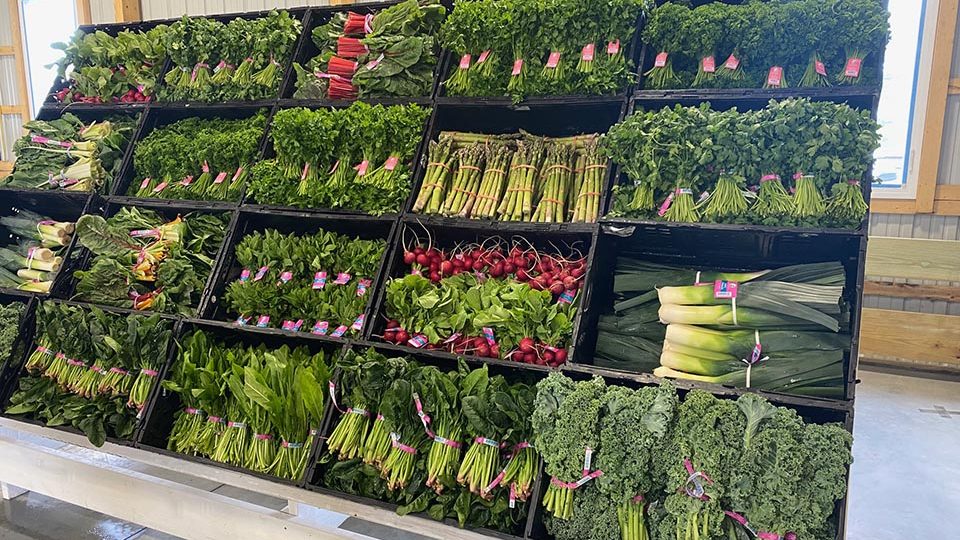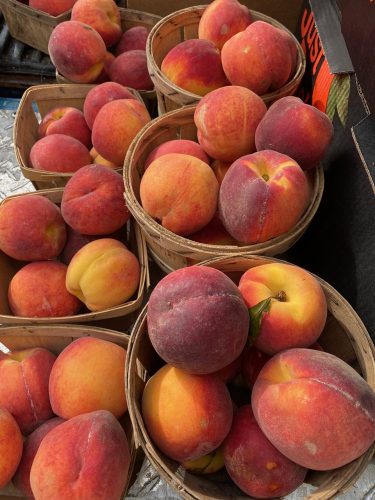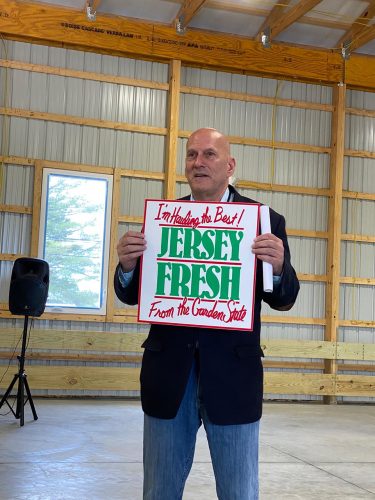State of Our Garden
The Garden State continues its Jersey Fresh legacy with a new secretary of agriculture. By William Sokolic

 In 1937, the Phillies finished 7th in the National League. The Eagles won just 2 games. The Hindenburg explosion rocked the country. And Amelia Earhart vanished.
In 1937, the Phillies finished 7th in the National League. The Eagles won just 2 games. The Hindenburg explosion rocked the country. And Amelia Earhart vanished.
Not the most pleasant of news, for sure. But Snow White and the Seven Dwarfs became an instant classic as Disney’s first animated feature. And Charles and Theresa Muzzarelli created their self-named farm in Vineland, the agricultural center of South Jersey.
Both film and farm have endured. Delmo Muzzarelli, one of Charles and Theresa’s five children, took over operations of the 20-acre farm, concentrating on pickles and sweet potatoes.
In 1980, Delmo’s son Charlie and wife Rita ran the farm (and the Phillies won their first World Series.) Since then, the farm has expanded to 300 acres and added more than two dozen different fruits and veggies to go with the sweet potatoes and pickles.
Rita Muzzarelli sold fresh produce from the back of a tractor-pulled wagon in 1984, and the next year, the company built a small roadside market.
Charlie Jr. and Dena represent the fourth generation to run their farm, along with Dena’s husband Henry Cifaloglio Jr. and Charlie Jr’s wife Rosalie.
Today, the market has expanded to carry more than 70 different fruits, vegetables, and specialty items. The roadside market is one of 147 operating in the state.
“They are a big part of retail,” says Ed Wengryn, appointed secretary of the Department of Agriculture earlier this year. He succeeds Cumberland County’s own Douglas Fisher, whose tenure as secretary was 14 years.
“Agriculture in New Jersey, and its almost 10,000 farms, is an important part of the state economy,” says Wengryn.
Despite the growth of Muzzarelli Farms, those in Cumberland County and the rest of southwestern New Jersey, tend to be smaller than those in Central and North Jersey. To bring the smaller farms into a system that works in modern times requires collaboration and cooperation, says Wengryn, whose interest in agriculture and horticulture began in his youth, he helped on the Wengryn family farm, a dairy and field crop operation. He worked with his father, growing and selling pumpkins and pick-your-own strawberries, as well as growing tomatoes in the summer and selling them to area delis.
Wengryn attended Delaware Valley University, graduating with a degree in ornamental horticulture. After college, he worked as a florist in both New York and at his own shop in Branchburg, NJ.
Prior to his appointment four months ago, Wengryn spent nearly 20 years representing the New Jersey Farm Bureau in coalitions with trade groups and agricultural associations.

“Institutional buyers such as schools and supermarkets have to let small farmers participate, Wengryn says. “With some current state and federal programs schools and food banks are supposed to use some of their funds to purchase local products and invest in local food systems. One way to ensure that investment, rather than working with many small farms is to work through cooperatives to have a larger and greater supply.
“We have seen many smaller wholesale operations consolidated into fewer larger operations which can better handle investments in labor saving and food safety and quality control infrastructure. As farmers aged out, younger farmers were willing to take on the land and equipment expenses.”
The collaboration increased the size of farms from 80- to 100-acre operations to 500- to 800-acre farms.
“Everyone has a part to play in the modern take on farming—from our smaller farms to larger brokers, buyers, retailers and the consumer,” Wengryn says.
It’s more than preserving Jersey Fresh, it’s about partners, buyers and growers.South Jersey, which grows a higher percentage of corn and soybeans, has less direct marketing than Central and North Jersey.
One of the major strengths of the state agriculture system is the farm preservation program. The corporate business tax (CBT)pays for the fund and is one of the most successful in the country.
The main thrust is to keep farmers from selling to developers.
“To be worth preserving, farmland has to be under development pressure. If not, there is no value,” Wengryn says.
The farm preservation program involves more outreach at the local level. Counties and municipalities need help to approach local farms, he says.
But preservation is not enough.
“We have to come up with a new formula for land that is critical for agriculture, the most productive and viable operations and add value to those assets,” Wengryn says.
The CBT is a solid stable source of funding, but it is dedicated to land preservation.
“We may need other sources to help in farm viability sustainability, and long term investments in technology, efficiency and distribution and processing systems. The whole food chain,” Wengryn says.
New Jersey By The Numbers: There’s a reason we are called the Garden State.
The nursery industry is the biggest in sales volume in New Jersey.
Also successful are apples, peaches, blueberries, cranberries, tomatoes, melons, sweet corn, and all types of greens and South Jersey grows much of that.
The largest land use by product is for hay, corn, wheat and soybeans.
There are 40 dairy farms. “It’s a small segment, but an important part of agriculture, processing cheese, ice cream, and yogurt,” Wengryn says.
The U.S. Department of Agriculture conducts a census every five years with the last one in 2022. According to the census, New Jersey added 115 new farms, going against the national trend which saw a decrease in the numbers.
“It is encouraging to see that more residents of our state are taking a deeper interest in our industry by becoming more heavily involved in agriculture,” New Jersey Assistant Secretary of Agriculture Joe Atchison III said in a press release on the census in February. “This shows there are opportunities to farm here.”
New Jersey’s overall sale of agricultural products increased from just over $1.1 billion in 2017, to almost $1.5 billion in 2022.
The data showed that the nursery, greenhouse, floriculture, and sod industry continue to be New Jersey’s leading agricultural sector with sales at almost $725 million, an increase of $225 million from the previous census.
The vegetable industry is New Jersey’s second highest in sales at nearly $295 million, followed by fruits and berries at around $200 million. The top three sectors comprise more than 80 percent of total sales for New Jersey agriculture. The census showed that New Jersey continues to be among the top producers in the U.S. of several crops such as eggplant at No. 3, cranberries, and asparagus each at No. 4, and blueberries at No. 5.
New Jersey ranks in the top 10 nationally in production of these other crops: tomatoes, plums, bell peppers, spinach, Bok choy, escarole, kale, and romaine lettuce among others. New Jersey ranks 4 with peaches. South Jersey produces a high percentage of these products.
Cumberland County ranks first in the state in total sales, as well as in horticulture, according to the 2022 census.
However, despite the successful preservation system, the amount of land in farms decreased to nearly 712,000 acres, down from the 2017 census number of 734,000 acres, when 20,000 acres of farmland were added. The percentage of decreased farmland in New Jersey was almost even with the national average, which saw a decrease of 2.0 percent.
The expense to farm in New Jersey increased by an average of $37,000 per farm per year, which was well below the national average increase of more than $60,000 per farm.
Conducted since 1840, the Census of Agriculture accounts for all U.S. farms and ranches and the people who operate them. To be counted in the federal census, a farm must have sold or had the potential to sell at least $1,000 worth of agricultural products. More detailed data will be released throughout 2024, including information on individual counties, and congressional district profiles and rankings.
Preserved Land Acreage
- Salem County, Rank 1, Acres preserved: 37,369
- Cumberland County, Rank 5, Acres preserved: 20,400
- Gloucester County, Rank 8, Acres preserved: 15,208
Farm Overview
- Cumberland County: number of farms: 539, down 4 percent
- Gloucester County: number of farms 546, down 6 percent
- Salem County: number of farms 779, no change









